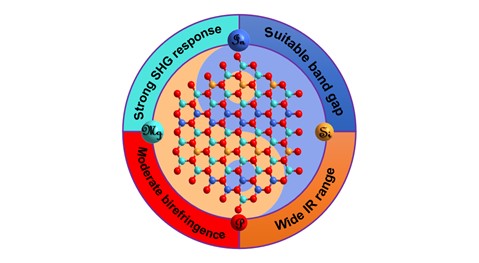Mid-infrared (mid-IR) nonlinear optical (NLO) materials can generate a coherent tunable laser in the mid-IR region (2.5-25 μm). The leading IR NLO crystals are AgGaS2, AgGaSe2 and ZnGeP2 cannot meet the increasing market requirements. Therefore, it is imperative to design and synthesize new IR-NLO materials with superior comprehensive optical performances.
In a study published in J. Am. Chem. Soc., Prof. YE Ning’s group from Fujian Institute of Research on the Structure of Matter (FJIRSM) of the Chinese Academy of Sciences (CAS) reported a design and synthesis of the first quaternary diamond-like phosphide infrared nonlinear optical material, Mg2In3Si2P7 (MISP).
By applying a “rigidity-flexibility coupling” strategy inspired from the traditional Chinese wisdom of Tai Ji, “coupling hardness with softness” i.e., the synchronous introducing of flexible groups [InP4] tetrahedra and rigid groups [SiP4] tetrahedra into diamond-like structure, the researchers obtained the first quaternary diamond-like phosphide, MISP with wurtzite-type superstructure.
MISP featured a diamond-like structure constructed by vertex-sharing [Mg/InP4], [In/SiP4], and [SiP4] tetrahedra.
The researchers designed the chemical formula of MISP based on the evolution of 2 × II-IV-V2 +3 × III-V, and it can be viewed as a chemical substitution process in which 7 Zn2+and 7 Ge4+ inZnGeP2 were replaced by 4 Mg2+,6 In3+, and 4 Si4+.
As expected, MISP realized the rare coexistence of a strong second-harmonic generation (SHG) effect (2 × ZnGeP2 and 7.1 × AgGaS2), suitable band gap (2.21 eV), moderate birefringence (0.107), and wide IR transparent range (0.56-16.4 μm), which is the first so-called “all in one” pnictide NLO material to date.
Under the excitation of a 565 nm laser, MISP had a near-IR emission peak at around 1100 nm with a full width at half-maximum (fwhm) of ca. 200 nm, and the emission peak was about 1067 meV red-shifted in comparison with the excitation peak.
The broad emission peak and large stokes shift indicated that MISP might become a laser self-frequency doubling (SFD) crystal and has potential applications in other optoelectronic fields.
According to the researchers, the excellent thermal and lattice stability of MISP ensured that it had great potential in high power laser fields.
This study not only opens a new avenue for designing advanced infrared nonlinear optical materials but also may spur more explorations on quaternary diamond-like pnictides.

Mg2In3Si2P7 realized giant second-harmonic generation, suitable band gap, moderate birefringence, and wide IR transparent range under “rigidity-flexibility coupling” strategy (Image by Prof. YE’s group)
Contact:
Prof. YE Ning
Fujian Institute of Research on the Structure of Matter
Chinese Academy of Sciences
Email: nye@fjirsm.ac.cn